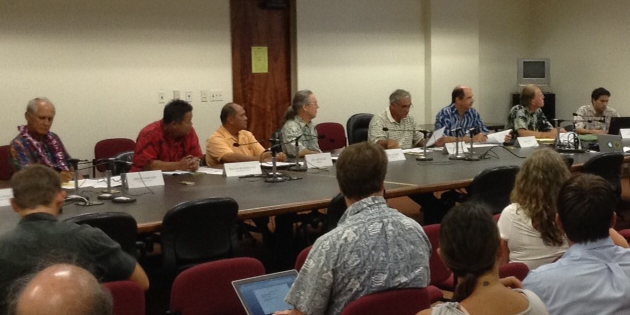
Members and legislative participants of the Hawaii Invasive Species Council review an interagency budget for invasive species projects in Fiscal Year 2015. Photo: Christy Martin
The interagency Hawaii Invasive Species Council (HISC) has approved a budget of $5,750,000 to support invasive species projects statewide in Fiscal Year 2015 (FY15). Funding for the HISC is allocated by the Hawaii State Legislature, which approved a joint majority package in the 2014 legislative session to greatly increase the State’s investment in curtailing invasive species impacts. The HISC voting members are the directors or designees of the Department of Land and Natural Resources (DLNR), Hawaii Department of Agriculture (HDOA), Department of Health (DOH), Department of Transportation (DOT), Department of Business, Economic Development and Tourism (DBEDT), and the University of Hawai‘i (UH).
At a meeting of the HISC on June 26, 2014, the Council reviewed and approved an interagency spending plan for FY15, based on a staff recommendation created after evaluating and prioritizing 61 proposals, totaling $10.4M, received from various agencies. Stated priorities for HISC funding in FY15 included detection and control of, and research pertaining to, the Little Fire Ant and Coconut Rhinoceros Beetle, as well as research on potential biocontrol agents for cost-effective control of widespread invasive pests. Support for on-the-ground prevention, control, and outreach capacity statewide was also a high priority this year.
Full details of the FY15 budget can be found on our FY15 Funded Projects Page, where award amounts and executive summaries are available for each of the 42 projects approved by the Council. Highlights of the FY15 budget include:
Statewide
- Support for detection and control of the Little Fire Ant statewide, including support for the Hawaii Ant Lab, a research and implementation project of the University of Hawaii’s Pacific Cooperative Studies Unit
- A pilot program training detector dogs to search for Little Fire Ants, with the goal of greatly increasing efficacy of detecting ants in transported commodities and on infested properties
- Support for the response to the Coconut Rhinoceros Beetle infestation on O‘ahu, including training opportunities for staff from other islands to quickly detect this species should it spread statewide
- Training for detection and rapid response for Brown Tree Snake in each county
- Training opportunities for community members to become early detectors of Varroa mite, a beehive pest threatening our State’s key pollinators, as well as our honey and queen bee production industries
- Research on cost-effective biocontrol strategies for widespread invasive plants, including albizia, miconia, Himalayan ginger, and others
- Improvements to www.reportapest.org, an online public reporting tool being developed as a potential web complement to the Statewide Pest Hotline, 643-PEST
Kaua‘i
- Support for the detection and control of mongoose on Kaua‘i
- Island-wise outreach, control, and detection by the Kaua‘i Invasive Species Committee
O‘ahu
- Support for interagency response to Little Fire Ant and Coconut Rhinoceros Beetle, led by the Hawaii Department of Agriculture
- Increased capacity for control of invasive algae in Kāne‘ohe Bay under the DLNR Division of Aquatic Resources
- Distribution of the approved biocontrol agent for slowing the spread of invasive strawberry guava
- Control of invasive plants including mule’s foot fern and cane tibouchina, as well as invasive animals including goats and sheep in the Ko‘olau mountains
- Island-wide outreach, control, and detection by the O‘ahu Invasive Species Committee
Maui Nui
- Eradication of Himalayan ginger from Moloka‘i, under the DLNR Division of Forestry & Wildlife
- Support for management of axis deer on Maui Island under the Maui Axis Deer Working Group
- Statewide broadcast of the Little Fire Ant outreach video produced by the Maui Invasive Species Committee
- Detection and control of priority species identified by the Maui & Moloka‘i Invasive Species Committees
Hawai‘i Island
- Little Fire Ant community outreach, control, and training opportunities via the Hawaii Ant Lab in Hilo (www.littlefireants.com)
- Support for a project to control Little Fire Ants in Hawaii County parks
- Detection and control of axis deer
- Support for control of an incipient plant, Photinia davidiana, spreading on Mauna Kea
- Island-wide detection, control, and outreach regarding priority species under the Big Island Invasive Species Committee